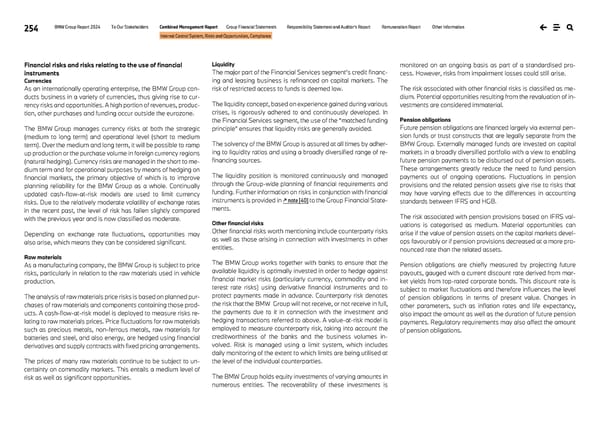254 BMW Group Report 2024 To Our Stakeholders Combined Management Report Group Financial Statements Responsibility Statement and Auditor’s Report Remuneration Report Other Information Internal Control System, Risks and Opportunities, Compliance Financial risks and risks relating to the use of financial instruments Currencies As an internationally operating enterprise, the BMW Group con- ducts business in a variety of currencies, thus giving rise to cur- rency risks and opportunities. A high portion of revenues, produc- tion, other purchases and funding occur outside the eurozone. The BMW Group manages currency risks at both the strategic (medium to long term) and operational level (short to medium term). Over the medium and long term, it will be possible to ramp up production or the purchase volume in foreign currency regions (natural hedging). Currency risks are managed in the short to me- dium term and for operational purposes by means of hedging on financial markets, the primary objective of which is to improve planning reliability for the BMW Group as a whole. Continually updated cash-flow-at-risk models are used to limit currency risks. Due to the relatively moderate volatility of exchange rates in the recent past, the level of risk has fallen slightly compared with the previous year and is now classified as moderate. Depending on exchange rate fluctuations, opportunities may also arise, which means they can be considered significant. Raw materials As a manufacturing company, the BMW Group is subject to price risks, particularly in relation to the raw materials used in vehicle production. The analysis of raw materials price risks is based on planned pur- chases of raw materials and components containing those prod- ucts. A cash-flow-at-risk model is deployed to measure risks re- lating to raw materials prices. Price fluctuations for raw materials such as precious metals, non-ferrous metals, raw materials for batteries and steel, and also energy, are hedged using financial derivatives and supply contracts with fixed pricing arrangements. The prices of many raw materials continue to be subject to un- certainty on commodity markets. This entails a medium level of risk as well as significant opportunities. Liquidity The major part of the Financial Services segment’s credit financ- ing and leasing business is refinanced on capital markets. The risk of restricted access to funds is deemed low. The liquidity concept, based on experience gained during various crises, is rigorously adhered to and continuously developed. In the Financial Services segment, the use of the “matched funding principle” ensures that liquidity risks are generally avoided. The solvency of the BMW Group is assured at all times by adher- ing to liquidity ratios and using a broadly diversified range of re- financing sources. The liquidity position is monitored continuously and managed through the Group-wide planning of financial requirements and funding. Further information on risks in conjunction with financial instruments is provided in ↗ note [40] to the Group Financial State- ments. Other financial risks Other financial risks worth mentioning include counterparty risks as well as those arising in connection with investments in other entities. The BMW Group works together with banks to ensure that the available liquidity is optimally invested in order to hedge against financial market risks (particularly currency, commodity and in- terest rate risks) using derivative financial instruments and to protect payments made in advance. Counterparty risk denotes the risk that the BMW Group will not receive, or not receive in full, the payments due to it in connection with the investment and hedging transactions referred to above. A value-at-risk model is employed to measure counterparty risk, taking into account the creditworthiness of the banks and the business volumes in- volved. Risk is managed using a limit system, which includes daily monitoring of the extent to which limits are being utilised at the level of the individual counterparties. The BMW Group holds equity investments of varying amounts in numerous entities. The recoverability of these investments is monitored on an ongoing basis as part of a standardised pro- cess. However, risks from impairment losses could still arise. The risk associated with other financial risks is classified as me- dium. Potential opportunities resulting from the revaluation of in- vestments are considered immaterial. Pension obligations Future pension obligations are financed largely via external pen- sion funds or trust constructs that are legally separate from the BMW Group. Externally managed funds are invested on capital markets in a broadly diversified portfolio with a view to enabling future pension payments to be disbursed out of pension assets. These arrangements greatly reduce the need to fund pension payments out of ongoing operations. Fluctuations in pension provisions and the related pension assets give rise to risks that may have varying effects due to the differences in accounting standards between IFRS and HGB. The risk associated with pension provisions based on IFRS val- uations is categorised as medium. Material opportunities can arise if the value of pension assets on the capital markets devel- ops favourably or if pension provisions decreased at a more pro- nounced rate than the related assets. Pension obligations are chiefly measured by projecting future payouts, gauged with a current discount rate derived from mar- ket yields from top-rated corporate bonds. This discount rate is subject to market fluctuations and therefore influences the level of pension obligations in terms of present value. Changes in other parameters, such as inflation rates and life expectancy, also impact the amount as well as the duration of future pension payments. Regulatory requirements may also affect the amount of pension obligations.
 BMW Group Report 2024 Page 253 Page 255
BMW Group Report 2024 Page 253 Page 255